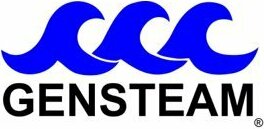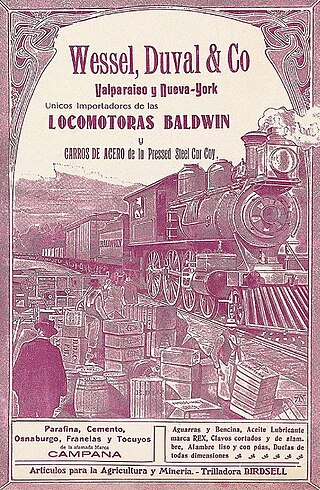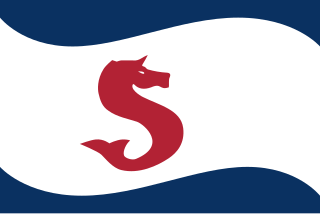
Luna is a historic tugboat normally berthed in Boston Harbor, Massachusetts. Luna was designed in 1930 by John G. Alden and built by M.M. Davis and Bethlehem Steel. She is listed on the National Register of Historic Places and is a U.S. National Historic Landmark. In 1985, the Luna was designated as a Boston Landmark by the Boston Landmarks Commission.

James Lorin Richards was an American financier and industrialist based in Boston, Massachusetts.

General Steamship Company was founded in 1920 in Houston, Texas, United States, as a Private Company, and now goes by Gensteam since 1996. General Steamship Company has a fleet of cargo ships that operate worldwide. Gensteam has a Gensteam Operations Desk website that tracks all shipping logistics. Gensteam headquarters is now in San Francisco, California. General Steamship Company was part owner of American Pacific Steamship Company in New York state and Los Angeles during and post World War II. American Pacific Steamship Company was founded in 1942 in New York City, and was previously called Los Angeles Tanker Operators Inc. which operated T2 tanker ships. During World War II the General Steamship Company and American Pacific Steamship Company were active with charter shipping with the Maritime Commission and War Shipping Administration.

Agwilines Inc was a passenger and cargo shipping company of New York City. Agwilines is short for Atlantic, Gulf & West Indies Steamship Inc. AGWI Lines group operated four main lines in the 1910s, 1920s and 1930s:

Black Diamond Steamship Company (BDSC) operated passenger and cargo liners from New York City to Rotterdam and Antwerp. It was founded by J.E. Dockendorff in 1919, and named the American Diamond Line by the United States Shipping Board. The company was profitable in the 1920s and early 1930s. Prior to the United States' entry into World War II, the nation's neutrality policy ended much of the lines trade. Dockendorff stepped down as a principal executive in 1934, selling the only one of the company's 21 ships not owned by the government: New Britain, which he had bought in 1918. During World War II the company sold most of its American Diamond Line ships and moved to charter shipping with the Maritime Commission and War Shipping Administration. During the war, the Black Diamond Steamship Company operated Victory ships and Liberty ships. These ships were operated by their own crews; the US Navy supplied United States Navy Armed Guards to man the deck guns and radio. The most common armament mounted on these merchant ships were the MK II 20mm Oerlikon autocannon and the 3"/50, 4"/50, and 5"/38 deck guns. After the war there were many surplus ships and much competition. Black Diamond Steamship Company continued to operate after the war, but finally closed in 1955.
Weyerhaeuser Steamship Company was a cargo Liner company founded in Tacoma, Washington. Weyerhaeuser Steamship Company was founded by Weyerhaeuser Company in 1933. Weyerhaeuser is one of the largest lumber and paper companies in the United States. First called the Weyerhaeuser Timber Company which started with ships for towing logs in the Northwestern United States. Weyerhaeuser started Weyerhaeuser Timber Company with a ship he acquired in 1892. The log towing ship was a 140-foot sternwheeler built for the partnership, Weyerhaeuser and Denkman Company. In 1923 Weyerhaeuser added to ocean lumber cargo ship the SS Pomona and the SS Hanley. The two ships took lumber to the East Coast. In 1933 F. Weyerhaeuser starts the Weyerhaeuser Steamship Company and moves the headquarters to Newark, New Jersey. At the outbreak of World War II the US government orders the four Weyerhaeuser to take supplies to the British army in Egypt. The next year the other four company's ships are requisitioned by the War Shipping Administration. During World War II the Weyerhaeuser Steamship Company was active in charter shipping with the Maritime Commission and War Shipping Administration. During wartime, the Weyerhaeuser Steamship Company operated Victory ships and Liberty ships. The ship was run by its crew and the US Navy supplied United States Navy Armed Guards to man the deck guns and radio. The most common armament mounted on these merchant ships were the MK II 20mm Oerlikon autocannon and the 3"/50, 4"/50, and 5"/38 deck guns. In 1942 the SS Potlatch and the SS Heffron were sunk by German U-boats torpedoes. After the war, Weyerhaeuser Steamship Company purchased four Liberty ships for intercoastal shipping service. In 1950 Weyerhaeuser Steamship Company purchases the Pacific Coast Direct Line and moves its headquarter from Newark to San Francisco. In 1962 the Weyerhaeuser Line is started and Weyerhaeuser Steamship becomes a division of Weyerhaeuser Company.

Wessel, Duval & Co. was founded in Boston, Massachusetts in 1825 Augustus Hemenway (1805-1876) as Hemenway & Co.. Augustus Hemenway started the shipping company to move his timber products to markets. Augustus Hemenway had timberland in Maine and started his schooner shipping company to take timber to Eastcoast ports. Later he opened a sugar plant in Cuba, his ships would take lumber to Cuba and bring back sugar. Next, he expanded his timber products to Argentina and other Western South American ports. By 1828 the company expanded to Valparaiso, Chile. Augustus Hemenway married into a Boston merchant family, marrying Mary Tileston (1820-1894) in 1840. In 1865 Héctor Beéche (?-1914) became a partner in the firm and a subsidiary company, Wessel, Duval y Cía, was founded in Chile by Charles P. Hemenway, Augustus's brother. Charles had acted on Augustus' behalf in other matters as needed and became a partner in 1870. T. Quincy Browne became a partner in 1870 also and for a few years the firm was called Hemenway & Browne. In 1875 William Muller joined as a partner, the name returned to Hemenway & Co. Augustus Hemenway died in Cuba in 1876. The partnership continued as Hemenway & Co. till 1885. In 1885 Muller retired and Carlos Wolff joined the partnership, the company name was changed to Hemenway, Beeche and Co.. In 1888 Peter "Perdo" M. Wessel (1851-1821) joined the partnership and the company name was changed to Browne, Beeche and Co..

A. H. Bull Steamship Company was a shipping company and passenger liner service founded in New York City in 1902 by Archibald H. Bull (1848-1920). Service started with shipping between New York and Florida. His fleet of ships then added service to other Eastcoast ports. The company is also often called the Bull Lines and the Bull Steamship Line or A. H. Bull & Company. While founded in New York, Bull soon move its headquarter to Peir 5 in Baltimore, Maryland. Bull Lines main Eastcoast ports were: Baltimore, Charleston, Philadelphia, Tampa and Norfolk, Virginia. Oversea ports: Porto Rico, Antwerp, Bordeaux, Hamburg, Bremen, Copenhagen, and West Africa. Bull Steamship Line supported the US war effort for both World War I and World War II, including the loss of ships.

States Steamship Company, also called States Line and SSS, was started in 1928 by Charles Dant, in Portland, Oregon and later moved to the headquarters to San Francisco. Dant started the States Steamship Company to take his lumber product to market. He had a fleet of lumber schooners. Dant started by leasing ships from the United States Shipping Board - Emergency Fleet Corporation and founded the Columbia Pacific Steamship Company in 1919, Columbia Pacific Steamship Company routes were between Portland, Far East and Europe. In 1928 Dant merged the Columbia Pacific Steamship Company into the States Steamship Company. The Europe route ended in 1932 and the ship moved to a Philippines route. With the shift to container shipping in the 1960s and Dant's fleet of ships becoming older and obsolete, the company into bankruptcy in 1979. States Line operated four subsidies: Pacific-Atlantic Steamship Company, California Eastern Line founded in 1937 for lumber shipping, Oregon Oriental Line and the Quaker Line.
Sprague Energy, formerly Charles H. Sprague Company, C. H. Sprague and Son, is a Northeastern United States energy supplier. Charles H. Sprague Company was founded in 1870 in Boston by Charles H. Sprague. Charles H. Sprague Company delivered coal to New England cities from Newport News, Virginia. In 1905 Sprague expanded and opened the Penobscot Coal and Wharf Company in Searsport, Maine. This became the main supplier of US coal to Europe, particularly during World War II.

Merchants and Miners Transportation Company, often called M&M and Queen of Sea, was a major cargo and passenger shipping company founded in 1852 in Baltimore, Maryland. In 1852 is started with routes from Baltimore and Boston two wooden side wheelers ships. In 1859 M&M added two iron hulled steamers to its fleet. In 1866, post Civil War, M&M added routes to Providence, Rhode Island, Norfolk and Savannah, Georgia. In 1876 M&M purchased the Baltimore & Savannah Steamship Company add routes to Savannah, Jacksonville and Charleston. In 1907 the Winsor Line of Philadelphia's J. S. Winslow & Company of Portland, Maine was purchased, with seven steamships. The Winsor Line was founded in 1884 by J. S. Winslow. The Winsor Line first route was from Norfolk, Virginia to New England ports, supplying West Virginia coal. The Winsor Line sailing ship Addie M. Lawrence took ammunition to Europe during World War I. By World War II M&M had a fleet of 18 ships and add routes to Miami. With the outbreak of World War II the War Shipping Administration requisitioned Merchants and Miners Transportation Company fleet of ships for the war effort.
Boland and Cornelius Company was a shipping company founded in 1904 by Messrs Boland and Adam E. Cornelius in Buffalo, New York. Adam Edwards Cornelius came up with the idea of having self-unloading ships to save time and money. Adam Edwards Cornelius self-unloading ships changed the way ships were unloading. In 1907 Boland and Cornelius founded the American Steamship Company a subsidiary of Boland and Cornelius Company. American Steamship Company later became the current GATX Corporation. Boland and Cornelius Company flew a white and red flag with B&C in blue.
Simpson Spence & Young, (SSY), Simpson Spence Young, Simpson, Spence & Young Ltd. was founded in 1880 by Ernest Simpson, Lewis Spence and Captain William Young in New York City. Ernest Louis Simpson started as a shipbroker from England. Simpson joined with shipbroker Lewis H. Spence and started Simpson & Spence in 1880. In 1882 Captain William Young joined the company and the name was changed to Simpson Spence & Young. Simpson Spence & Young opened a second office in Newcastle upon Tyne in England. Simpson son Ernest Aldrich Simpson (1897-1958) joined the company. The Simpson Spence & Young became very successful and becoming a worldwide shipping firm, with headquarters in London, one of the largest shipbrokers. Simpson Spence Young has 19 offices worldwide with over 400 employees. Simpson Spence Young operates dry bulk, tanker ships, tugboats and has other services.

Wilmore Steamship Company was a steamship shipping company that was founded in New York City in 1930. The Wilmore Steamship Company mainly operated coal ships, called Collier ship. The coal ships main routes were loading coal at Hampton Roads, Virginia, and delivering the coal to New England ports. The first two ships on the route were the SS Berwindglen and SS Berwindvale. Both ships were built by Bethlehem Steel's Bethlehem Shipbuilding Corporation at Quincy, Massachusetts, at the Fore River Shipyard. SS Berwindglen and SS Berwindvale were new 4,411-ton colliers ships, that had first United States engines that used pulverized coal-fired boilers. The steamship SS Mercer, a 9,500 ton merchant ship was the test ship of pulverized coal, modified to evaluated pulverized coal in 1929. The test were good and the SS Berwindglen and SS Berwindvale were built for this new fuel. Wilmore Steamship Company was named after Wilmore Heights, Pennsylvania. Wilmore Steamship Company was active in supporting the World War II effort.

Pocahontas Fuel Company operated mines in the state of Virginia in Boissevain and Amonate, and in West Virginia at Jenkinjones, Bishop, and Itmann. Pocahontas Fuel Company founded the Pocahontas Consolidated Collieries Company in 1907. In 1956 Pocahontas was acquired by the Consolidation Coal Company. Consolidation Coal Company became Consol Energy in 1991. Consol Energy mines coal at Amonate. Pocahontas Fuel Company used the Norfolk & Western Railway bring the coal to ports for shipment.
West India Steamship Company was a passenger and cargo steamship company founded in New York City in 1910. West India Steamship Company was founded by Edward R. Bacon, Robert Bacon and Daniel Bacon. Edward R. Bacon was an attorney and Daniel Bacon was a ship broker. Before founding West India Steamship Company all three had worked for the Barnes Steamship Company. They operated the West India Steamship Line. By 1913, West India Steamship Company had cargo routes from New York City and Norfolk, Virginia to Cuba, Mexico, Colón, Panama, and the Windward Islands. By 1921 West India Steamship Company added routes from Mobile, Alabama, to a number of West Indies ports. West India Steamship Company was active in supporting the World War II efforts.
Overlakes Freight Corporation was shipping agent company founded in New York City on April 21, 1932, by William M. Nicholson. Overlakes Freight Corporation operated Liberty Ships during and for post World War II efforts. Most of Overlakes Freight Corporation ships were purchased by the War Shipping Administration for the war. Nicholson also owned the Nicholson Universal Steamship Company, Nicholson, Erie, Dover, Ferry Line, Nicholson Terminal & Dock Company, Aqua Terminal & Dock Corporation and the Nicholson Transit Company.
Prudential Steamship Corporation was a shipping company founded in 1933 in New York City by Stephan Stephanidis. Prudential Steamship Corporation operated the Prudential Lines. Prudential Lines main routes was from the United States to Mediterranean ports. The Prudential Lines was never successful and was always near bankruptcy. Prudential Lines was active in supporting the World War II efforts. At its peak in the 1960s Prudential Lines owned and operated two tankers, and five cargo ships. In 1960 the Prudential Steamship Corporation was sold to Spyros Skouras and his family. In 1969 the Prudential Lines merged with Grace Lines, which continued to operate the fleet as the Prudential Grace Line.
William J. Rountree Company was a steamship agent and broker company founded by William J. Rountree in New York City in 1912. William J. Rountree Company was active in supporting the World War II effort by chartering and operating Liberty ships and Victory ships.
M & J Tracy Inc. was a shipping and tugboat towing company founded in New York City by the racy brothers in 1881, as M & J Tracy Transportation company. The brothers: John Tracy, Michael J. Tracy and Thomas Tracy founded the Tracy Towing Line in 1917. The brother's sisters: Catherine Tracy and Helen Tracy were on the company's board. M & J Tracy Inc. office was located at 1 Broadway in New York City and had a field office in Brooklyn. The Tracy companies owned both owned tugboats and barges. Early work was transporting coal to New York Harbor port in barges. M & J Tracy Inc. supported the World War II effort by operating United States tugboats and ships. After the war, M & J Tracy Inc. purchased some surplus ships. M & J Tracy Inc. also operated the M & J Tracy New York Harbor Industrial site. The family lived in the Frank J. Helmle 1912 Tracy Mansion at 105 8th Avenue, Brooklyn, New York, now a 7 unit Condo. John Tracy founded the Maritime Association of the Port of New York. John Tracy was born in 1855 and died on October 1, 1931. Michael J, Tracy died on November 7, 1927,











